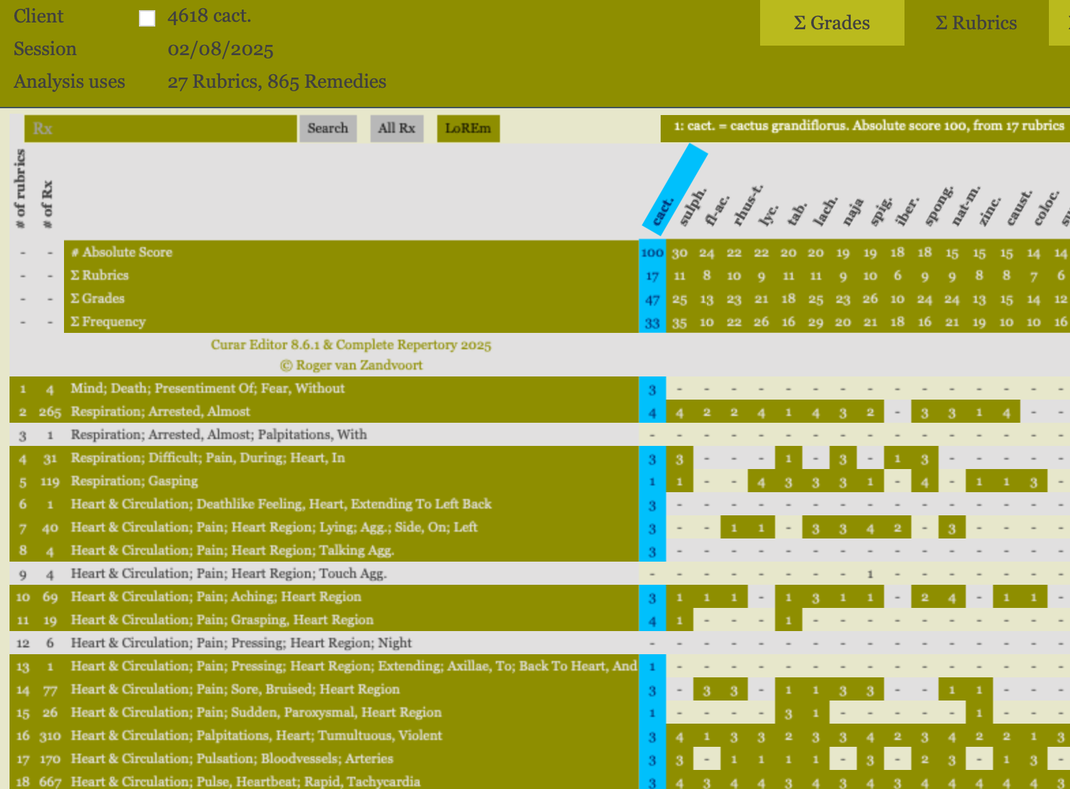
Organon 1878 vol. 01., p. 282, E. W. Berridge
Case III. -June 15th, 1871. Miss —, aged about sixty, had rheumatism in feet in April and May, of which I cured her. She remained well till yesterday evening, when great pressure at heart came on, going round under left axilla to left back, " like & belt of pain;" at midnight it became awful, like a hand grasping heart, with soreness, aching, and soreness to touch in all the affected region; also a sore aching in left arm down to elbow; the pain at heart was paroxysmal, worse on speaking or lying on left side; it caused dyspnea, the latter symptom being subsequent in point of time to the former. There was a deathlike feeling at heart and around the left back; pulse 105; sometimes the breath stops altogether for half a minute, but without unconsciousness, and the skin gets colder; afterwards she gasps. When the breath stops there is violent palpitation, and something seems to be whirling up from chest to brain, and all the arteries seem throbbing; she feels she is dying, and thinks she will not live to morning, but has no fear of death. She had a similar attack ten years ago, and has been told by a physician that the back of the heart was diseased. Cactus grand. 200 (prepared by Dr. James Lillie), at 3-30 a.m., and repeated every hour till better. Took second dose at 4-30 p.m., after which she became much better; the dyspnea improved first, then the pain (that is, in the reverse order to that of their appearance, as HAHNEMANN teaches), and she went to sleep. Took another dose at 6 a.m. At 2 p.m., much better, and has got up; feels nauseated; pulse 72. Got quite well, and when last seen in the following November, there had been no return.
Comments.—In the previous article, it was shown how each case was worked out using the Repertory, and how impossible it would have been to select the simillimum in any other way. In the present cases, no Repertory was used, but the remedy was chosen using keynote symptoms retained in the memory. A keynote is a symptom or group of symptoms so characteristic of a remedy that wherever we meet with it, we always, or almost always, find the remainder of the symptoms under that remedy also. Hence, in prescribing according to a keynote, we do not ignore the totality of the symptoms, but merely use this keynote as leading thereto. Cases occur, it is true, in which we cannot cover the totality of the symptoms, through the imperfections of our Materia Medica; in these cases keynotes are invaluable, because if we can cover these we may safely neglect the other vague and general symptoms which may be found under many medicines, though perhaps not under the one in question. In other cases, we may see two or more conflicting keynotes. Probably the proper remedy here is one as yet unknown, which comprises all. Still, in the meantime, we can only select the best indicated remedy, and when it has done all it can, make a fresh selection for the remaining symptoms. In a third class of cases, there may be no keynote discernible, all the symptoms being of nearly equal value, and all common to several remedies. In this case, the only plan is to eliminate one by one the medicines that do not have all the symptoms. A good knowledge of keynotes results in & significant saving of time and labor, though liable to abuse by the careless.
In the first of the above cases, the keynote was relief of heart symptoms by lying on the left side, & clinical symptom first pointed out by Dr. C. H. Burt, in the North American Journal of Homoeopathy, vol. 2 (new series), p. 198. The characteristic value of this symptom is enhanced by the fact that heart symptoms are usually worse when lying on the left side.
In the second patient, the keynote was found in the symptom, "Pinching pain in or by the heart, as if the heart were hanging by tightly drawn bands; mostly noticed on deep inspiration or coughing, not on motion of the body."
In the third case, the keynote was " Sensation of constriction in the heart, as if an iron hand prevented its normal movement." Several other medicines, e.g., arn., bufo., iod., lil., and nux-mosch, have varieties of compressive pain in heart, but only under cactus is it described as by a hand.
In all these cases there were several symptoms not yet found in the pathogeneses of the medicines given; by giving one medicine only at a time, and not alternating it with some other on the pretext of covering the remaining symptoms, not only were cures effected, but some additional clinical symptoms, of great value if verified, were ascertained. Dr. Burr's clinical facts, which here did such good service, are only another proof of the importance of carefully observed and thoroughly verified clinical symptoms, which supply many a gap in the pathogeneses of our Materia Medica. With this view, it will not be amiss to add here the following group cured by one dose of the same preparation of cactus:—" Contractive pain in region of the heart, going down to the left abdomen, it catches the breath; cold feeling in the chest at seat of pain; low spirited, and weeps."


Add comment
Comments
Thank you for this. Studying cured cases with repertory analysis is an excellent way to learn.
Would it be possible to display all rubrics in the analysis?